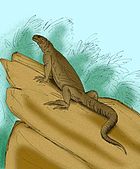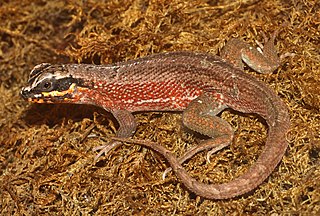
Iguania is an infraorder of squamate reptiles that includes iguanas, chameleons, agamids, and New World lizards like anoles and phrynosomatids. Using morphological features as a guide to evolutionary relationships, the Iguania are believed to form the sister group to the remainder of the Squamata, which comprise nearly 11,000 named species, roughly 2000 of which are iguanians. However, molecular information has placed Iguania well within the Squamata as sister taxa to the Anguimorpha and closely related to snakes. The order has been under debate and revisions after being classified by Charles Lewis Camp in 1923 due to difficulties finding adequate synapomorphic morphological characteristics. Most Iguanias are arboreal but there are several terrestrial groups. They usually have primitive fleshy, non-prehensile tongues, although the tongue is highly modified in chameleons. The group has a fossil record that extends back to the Early Jurassic. Today they are scattered occurring in Madagascar, the Fiji and Friendly Islands and Western Hemisphere.

Bagaceratops is a genus of small protoceratopsid dinosaurs that lived in Asia during the Late Cretaceous, around 72 to 71 million years ago. Bagaceratops remains have been reported from the Barun Goyot Formation and Bayan Mandahu Formation. One specimen may argue the possible presence of Bagaceratops in the Djadochta Formation.
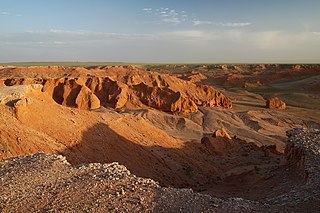
The Djadochta Formation is a highly fossiliferous geological formation situated in Central Asia, Gobi Desert, dating from the Late Cretaceous period, about 75 million to 71 million years ago. The type locality is the Bayn Dzak locality, famously known as the Flaming Cliffs. Reptile and mammal remains are among the fossils recovered from the formation.

Estesia is an extinct genus of Late Cretaceous anguimorph lizard found in the Gobi Desert in Mongolia.
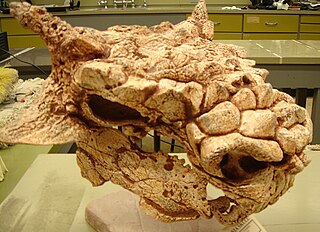
Minotaurasaurus is a monospecific genus of ankylosaurid dinosaur that lived in Mongolia during the Late Cretaceous in what is now the Djadochta Formation. The type and only species, Minotaurasaurus ramachandrani, is known from two skulls, a cervical vertebra and a cervical half ring. It was named and described in 2009 by Clifford Miles and Clark Miles. The first fossils of Minotaurasaurus were illegally exported out of Mongolia.It has been suggested to be a synonym of Tarchia but more recent publications consider it as a distinct genus.
Isodontosaurus is an extinct genus of iguanian lizard from the Late Cretaceous of Mongolia and China. The type species is Isodontosaurus gracilis. Isodontosaurus is part of an extinct group of Late Cretaceous iguanians called Gobiguania, which is currently thought to be endemic to Mongolia.
Aiolosaurus is an extinct genus of monitor lizard from the Late Cretaceous of Mongolia. The type and only species, Aiolosaurus oriens, was named in 2000 from Ukhaa Tolgod, a rich fossil site in the Campanian-age Djadochta Formation.
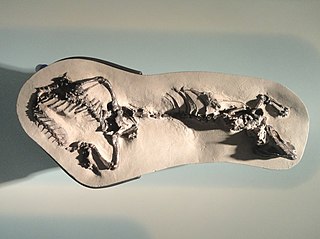
Polyglyphanodontia, also known as the Borioteiioidea, is an extinct clade of lizards from the Cretaceous that includes around a dozen genera. Polyglyphanodontians were the dominant group of lizards in North America and Asia during the Late Cretaceous. Most polyglyphanodontians are Late Cretaceous in age, though the oldest one, Kuwajimalla kagaensis, is known from the Early Cretaceous Kuwajima Formation (Japan). Early Cretaceous South American taxon Tijubina, and possibly also Olindalacerta, might also fall within Polyglyphanodontia or be closely allied to the group, but if so, they would be two of only four Gondwanan examples of an otherwise Laurasian clade. They produced a remarkable range of forms. Chamopsiids, including Chamops, were characterized by large, blunt, crushing teeth, and were most likely omnivores. Polyglyphanodon, from the Maastrichtian of Utah, was another herbivore, but its teeth formed a series of transverse blades, similar to those of Trilophosaurus. Peneteius had remarkable, multicusped teeth, similar to those of mammals. The polyglyphanodontids first appear in the latter part of the Early Cretaceous in North America, and became extinct during the Cretaceous-Paleogene extinction event. Polyglyphanodontians closely resembled the teiid lizards, and purported teiid lizards from the Late Cretaceous appear to be polyglyphanodontians. The only species known to have survived the Cretaceous was Chamops, which survived until the very early Ypresian.

Gobiguania is an extinct clade of iguanian lizards from the Late Cretaceous. All known gobiguanians are endemic to the Gobi Desert of Mongolia. Gobiguania was given a phylogenetic definition by Jack Conrad and Mark Norell in 2007 as all taxa more closely related to Anchaurosaurus gilmorei than to Iguana iguana, Crotaphytus collaris, or Agama agama. According to Conrad and Norell's phylogenetic analysis, Gobiguania includes Anchaurosaurus as well as several other Late Cretaceous lizards such as Ctenomastax, Temujinia, Saichangurvel, and Zapsosaurus. A phylogenetic analysis published in 2012 indicated that three other lizard genera — Igua, Isodontosaurus, and Polrussia, all from Mongolia and all from the Late Cretaceous — are also gobiguanians. Below is a cladogram from the analysis:
Myrmecodaptria is an extinct genus of scleroglossan lizard from the Late Cretaceous Djadokhta Formation in Ukhaa Tolgod, Mongolia. The type and only species, Myrmecodaptria microphagosa, was named in 2000 by paleontologists Gao Keqin and Mark Norell. Myrmecodaptria is known from a single holotype skull and lower jaws. It is distinguished from all other lizards by its extremely elongated skull. The eyes are placed close to the snout, which is short and rounded. The top of the skull is covered in bony knobs called osteoderms. The parietal bone at the back of the skull is elongated and about as long as the frontal bones, which are the usually the longest bones along the top of the skull in lizards. The squamosal bone at the back of the skull reaches forward to connect with the jugal bone behind the eye, forming a thin arch between the temporal fenestrae. Myrmecodaptria also has fewer and more widely spaced teeth in its jaws than do most other lizards.
Uquiasaurus is an extinct genus of iguanian lizards represented by the type species Uquiasaurus heptanodonta from the Late Pliocene of Argentina. Uquiasaurus was first described in 2012 on the basis of isolated snout and jaw bones within the Uquía Formation, the namesake of the genus. These bones were preserved in a midden of predatory bird pellets and are part of a microvertebrate assemblage that includes the bones of rodents, marsupials, frogs, birds, and other lizards, one of the few to document the mixing of North and South American faunas during the Great American Interchange. Phylogenetic analysis indicates that Uquiasaurus is part of a clade of iguanians that includes the living families Liolaemidae, Leiocephalidae, and Tropiduridae. The status of U. heptanodonta as a valid taxon was contested by Scanferla & Díaz-Fernández (2023), who reinterpreted the type series of this species as a fossil bone assemblage composed by more than one species of Liolaemus. Below is a cladogram from Daza et al. (2012) showing its phylogenetic relationships:
Priscagamidae is an extinct family of iguanian lizards known from the Late Cretaceous of Mongolia and China and the Eocene of India, spanning a range from 83.6 to 48.6 million years ago. Probably the earliest priscagamids on indeterminate genera were found in Aptian-Albian sediments in "Hobur", Mongolia. It includes the genera Heterodontagama, Mimeosaurus, Phrynosomimus, Priscagama, and possibly Pleurodontagama. The first fossils of priscagamids were found in the Djadochta and Khermeen Tsav formations of Mongolia. More recently they have been found in the Cambay Formation in India, leading to the naming of Heterodontagama in 2013. Priscagamidae was originally described as a subfamily of Agamidae called Priscagaminae in 1984, but it was reclassified as a distinct family in 1989. Most phylogenetic analyses still find a close relationship between Priscagamidae and Agamidae, although a 2015 study found it to be basal to all other iguanian clades, warranting its removal from Iguania and placement in a larger clade called Iguanomorpha.
Saichangurvel is an extinct genus of iguanian lizards from the Late Cretaceous of Mongolia. It is a member of a clade called Gobiguania, an exclusively Late Cretaceous group of iguanian lizards that was likely endemic to the Gobi Desert. The type species, Saichangurvel davidsoni, was named by paleontologists Jack Conrad and Mark Norell of the American Museum of Natural History in 2007. It is known from a single nearly complete and fully articulated skeleton called IGM 3/858, which was found eroding from a block of sandstone during a thunderstorm at a fossil locality called Ukhaa Tolgod. IGM 3/858 comes from the Djadochta Formation, which is between 75 and 71 million years in age. Just as it is today, the Gobi was a desert during the Cretaceous. IGM 3/858 may have died in a collapsing sand dune, the rapid burial preserving its skeleton in pristine condition.
Priscagama is an extinct genus of iguanian lizard from the Late Cretaceous of Mongolia and China. It belongs to an extinct family of iguanians called Priscagamidae. Several incomplete skulls have been found in the Barun Goyot and Djadochta formations, and were originally referred to the genus Mimeosaurus; the type species Priscagama gobiensis was named in 1984 when it was recognized that these skulls belonged to a distinct species. Priscagama differs from most other priscagamids in having a more elongate, lightly built skull. It is very similar in appearance to another priscagamid called Pleurodontagama, as the two can only be distinguished by the shape of their teeth.
Phrynosomimus is an extinct genus of iguanian lizard from the Late Cretaceous of Mongolia belonging to the extinct family Priscagamidae. The type species Phrynosomimus asper was named in 1996. Fossils have been found in the Barun Goyot and Djadochta formations and include several complete skulls. Phrynosomimus has a short, triangular skull with bony spikes projecting from the back, stemming from the squamosal and parietal bones. These spikes give it a similar appearance to the modern horned lizard Phrynosoma and inspire its name, which means "Phrynosoma mimic." Like other priscagamids it has an acrodont dentition, meaning that its teeth grow from the margins of the jaws rather than their inner surfaces, as is the case for the pleurodont dentitions of most lizards.
Xihaina is an extinct genus of iguanian lizard from the Late Cretaceous of Inner Mongolia, China. The type species Xihaina aquilonia was named in 1995 from the Djadochta Formation and is known from a partial skeleton that preserves parts of the skull, most of the vertebral column, the pelvis, and the right hind limb. The incomplete nature of this specimen makes the classification of Xihaina difficult; it has never been incorporated into a phylogenetic analysis, but it shares similarities with a group of Late Cretaceous Mongolian lizards called Gobiguania, particularly the gobiguanian genera Anchaurosaurus and Polrussia. The fact that many skeletal elements are missing yet the rest of the skeleton is articulated suggests the individual may have been partially eaten by a predator or scavenger and then rapidly buried soon after.
Polrussia is an extinct genus of iguanian lizards dating to the Late Cretaceous epoch, found in what is now Mongolia. It belongs to a group of extinct iguanians called Gobiguania that was endemic to the Gobi Desert during the Late Cretaceous. The type species Polrussia mongoliensis was named in 1991 on the basis of a skull found in the Barun Goyot Formation. The genus name refers to the Polish and Russian paleontologists who worked together to find and describe the material. Polrussia has a short skull, slightly pointed and flattened snout, and large eye sockets. The teeth each have one cusp, as opposed to the multiple cusps seen in some other gobiguanians. The skull is only 1.2 centimetres (0.47 in) long, making Polrussia one of the smallest gobiguanians.

Igua is an extinct genus of iguanian lizards belonging to a group called Gobiguania that was endemic to the Gobi Desert during the Late Cretaceous. The type species Igua minuta was named in 1991 on the basis of a skull from the Barun Goyot Formation in Mongolia. The skull itself is very small, only 14 millimetres (0.55 in) long, and may have belonged to a juvenile given that it possesses a large fontanelle and that many of the bones are unfused. The snout-vent length of the individual is estimated to have been 55 to 65 millimetres. Igua differs from related gobiguanians like Polrussia in having a more rounded skull. It is similar in appearance to the living genera Liolaemus and Tropidurus. The teeth are tricuspid and pleurodont, meaning they are attached to inner surfaces of the jaws.
Magnuviator is a genus of extinct iguanomorph lizard from the Late Cretaceous of Montana, US. It contains one species, M. ovimonsensis, described in 2017 by DeMar et al. from two specimens that were discovered in the Egg Mountain nesting site. Magnuviator is closest related to the Asian Saichangurvel and Temujinia, which form the group Temujiniidae. Unlike other members of the Iguanomorpha, however, Magnuviator bears a distinct articulating notch on its tibia for the ankle bones, which has traditionally been considered a characteristic of non-iguanomorph lizards. The morphology of its teeth suggests that its diet would have mainly consisted of wasps, like the modern phyrnosomatid iguanians Callisaurus and Urosaurus, although it also shows some adaptations to herbivory.

Slavoia is an extinct genus of lizard from the Late Cretaceous of Kazakhstan and Mongolia, there is only a single species S. darevskii.Slavoia has been suggested to be the oldest known relative of amphisbaenians.








